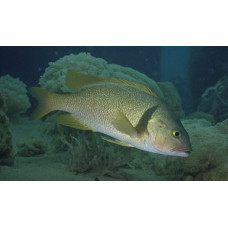Latin name
Lutjanus rivulatus
Other name
Maori snapper, blue-spotted seaperch, Maori bream, Maori seaperch, multi-coloured snapper, scribbled snapper, speckled snapper or yellowfin snapper.
Identification
The Blubberlip Snapper has a very deep body, with a standard length of just over twice the body depth at its deepest point. The forehead is steeply sloped and the tubercle and tarsal groove are moderately developed. The front teeth are crescent-shaped and not set back, and the smooth tongue is not toothed. The lips are thickened.
Features of fish fins
The dorsal fin of this species contains 10 spines and 15-16 soft rays while the anal fin has 3 spines and 8 soft rays, the dorsal fin has a rounded profile at the back while the anal fin is sharply pointed. The pectoral fins have 17 rays and the caudal fin is either truncated or weakly pointed.
Fish colouring
Blubberlip Snapper have an overall brown colour with a reddish tinge and contrasting bright yellow outer dorsal, anal and caudal fins. There is a pattern of blue lines on the head and smaller blue bars and dots on the body with a blurred dark band at the base of the pectoral fin which becomes less distinct as the fish grows. In addition to this stripe, juveniles have a white patch on the flanks. Juveniles are also marked with 3-8 dark vertical stripes.
Distribution
This species has a large Indo-Pacific range. It occurs from the east African coast between the southern Red Sea and South Africa, east into the Pacific Ocean to Tahiti and the Australian Islands, north to Japan and south to Australia. In Australian waters, the species is found from Port Hedland and the offshore reefs of Western Australia, Ashmore Reef in the Timor Sea and further east and south to northern New South Wales, as well as the Coral Sea and Christmas Island.
Habitat
It is a tropical marine fish. It is found at depths of 1.5 to 100 m (4 ft 11 in and 328 ft 1 in) and is associated with reefs, with adults found on deep coastal slopes and juveniles on algae-covered shoals, often near freshwater sources.
Size
The maximum total length of this species reaches 80 cm (31 inches), although 60 cm (24 inches) is more typical, and the maximum published weight is 11 kg (24 pounds).
Behavior
Blubberlip Snapper can be found as individuals or in small schools of 15-20. Despite its large size, it is a cautious fish.
Food and feeding habits
Like other basses, this species is predatory, feeding on fish, cephalopods and bottom-dwelling crustaceans.
Reproduction
Blubberlip snapper are usually sexually mature when the fish are about 50 centimetres (20 inches) long, although sexually mature individuals can reach 37 centimetres (15 inches). They form schools to spawn.
Fishing
It is an important species for artisanal fisheries throughout its range and is caught with lines, traps and gillnets, rarely trawls.
Relationship with a person
Blubberlip snapper is considered an excellent fish to eat, although eating its meat has been linked to cases of ciguatera contamination. It is sold in the live fish trade in Hong Kong and is farmed in South East Asia.
| Classification | |
| Phylum | Chordata |
| Class | Actinopterygii |
| Squad | Acanthuriformes |
| Family | Lutjanidae |
| Genus | Lutjanus |
| Species | L. rivulatus |
| Features | |
| Conservation status | Least Concern |
| Habitat | Pelagic |
| Life span, years | No information |
| Maximum body weight, kg | 11 |
| Maximum length, cm | 80 |
| Sailing speed, m/s | No information |
| Threat to people | Edible |
| Way of eating | Predator |
Blubberlip snapper
Tags: blubberlip snapper

